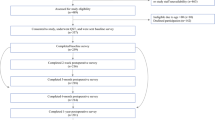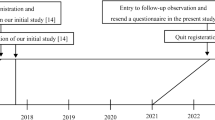Abstract
Persistent pain is a common but undesirable outcome of breast cancer surgery. With the increasing popularity of breast reconstruction after mastectomy for breast cancer, researchers have recently directed attention to the prevalence of intractable pain due to reconstructive surgery. However, available studies that examine factors associated with the development of postreconstruction pain are limited to clinical investigations that have been descriptive, retrospective, or cross-sectional in their study design. There is obvious clinical value identifying presurgical factors that are associated with increased risk for the onset of chronic pain after breast reconstruction surgery. This prospective study examined the effect of presurgical psychological distress and somatic preoccupation in predicting persistent pain after postmastectomy reconstructive surgery. Two hundred and ninety-five women seeking reconstruction at the time of mastectomy or delayed from prior mastectomy served as the subject pool. Surgical intervention included either expander/implant or autologous tissue reconstruction. Before surgery, subjects completed psychological inventories to assess levels of affective distress, somatization, depressive and anxiety symptoms, and somatic anxiety/preoccupation. At 1- and 2-year follow-up, subjects rated the degree to which they experienced problems with breast pain, abdominal pain, and back pain. Multiple linear regression analyses indicated that affective distress, depressive and anxiety symptoms, and somatization held significant association with abdominal and back pain at both 1- and 2-year follow-up. For breast pain, all the psychological measures predicted more severe pain at 1 year, but none retained significant association at year 2. Somatic anxiety had more variable relation to pain complaints. These data highlight pain morbidity as a potential negative outcome of breast reconstruction and the significant influence of affective distress and somatic preoccupation in the development of postreconstruction chronic pain. These data support continued investigation into the role of presurgical psychological screening and intervention for women seeking reconstructive surgery.
Similar content being viewed by others
References
Gottrup H, Anderson J, Arendt-Nielsen L, Jensen, TS (2000) Psychophysical examination in patients with post-mastectomy pain. Pain 87:275–284
Tasmuth T, Smitten K, Kalso E (1996) Pain and other symptoms during the first year after radical and conventional surgery for breast cancer. Br J Cancer 74:2024–2031
Wallace MS, Wallace AM, Lee J, Dobke MK (1996) Pain with breast surgery: a 282 women. Pain 66:195–205
Stevens PE, Dibble SL, Miaskowski C (1995) Prevalence, characteristics, and impact of postmastectomy pain syndrome: an investigation of women’s experiences. Pain 61:453–459
Foley KM (1978) Pain syndromes in patients with breast cancer. Med Clin N Am 71:177–178
Burckhardt CC, Jones KD (2005) Effects of chronic widespread pain in the health status and quality of life of women after breast cancer surgery. Health Qual Life Outcomes 3:30
Malata CM, McIntosh SA, Purushotham AD (2000) Immediate breast reconstruction after mastectomy: a review. Br J Surg 87:1455–1472
Caffo O, Amichetti M, Ferro A, Lucenti A, Valduga F, Galligioni E (2003) Pain and quality of life after surgery for breast cancer. Breast Cancer Res Treat 80:39–48
Mizgala CL, Hartrampf CR, Bennett GR (1994) Assessment of the abdominal wall after pedicled TRAM flap surgery: 5–7 year follow-up of 150 patients. Plast Reconstr Surg 93:988–1002
Huang TT (1990) Breast and subscapular pain following submuscular placement of breast prostheses. Plast Reconstr Surg 86:275–280
Jabaley ME, Das SK (1986) Late breast pain following reconstruction with polyurethrane-covered implants. Plast Reconstr Surg 78:390–395
Janson RA (1985) Implant arm: axillary compression from breast prostheses. Plast Reconstr Surg 75:420–422
Wilkins EG, Lowery JC, Smith D, Kim HM, Kuzon WM (2002) Prospective analysis of functional outcomes in breast reconstruction: two year postoperative results. 80th Annual Meeting of the American Association of Plastic Surgeons, Charleston, SC, May 13–16
Block AR (1996) Presurgical psychological screening in chronic pain syndromes: a guide to the behavioral health practitioner. Erlbaum, Mahwah, NJ
Kiecolt-Glaser JK, Page GG, Marucha PT, MacCallum RC, Glaser, R (1998) Psychological influences on surgical recovery: perspectives from psychoneuroimmunology. Am Psychol 53:1209–1218
Johnston M, Vögel C (1993) Benefits of psychological preparation for surgery: a meta-analysis. Ann Behav Med 15:245–256
Gilboa D, Borenstein A, Floro S, Shafir R, Falach H (1990) Emotional and psychosocial adjustment of women to breast reconstruction and detection of subgroups at risk for psychological morbidity. Ann Plast Surg 25:397–401
Holmberg L, Zaren E, Adami HO, Bergstrom R, Burns T (1988) The patient’s appraisal of the cosmetic result of segmental mastectomy in benign and malignant disease. Ann Surg 207:189–194
Roth RS, Wilkins EG, Lowery JC, Davis J. (2005) Quality of life and affective distress in women seeking immediate versus delayed breast reconstruction following mastectomy for breast cancer. Plast Reconstr Surg 116:993–1002
Meyerowitz BE (1980) Psychosocial correlates of breast cancer and its treatment. Psychol Bull 87:108–131
Irvine D, Brown, B, Crooks D, Roberts J, Bowne, G (1991) Psychosocial adjustment in women with breast cancer. Cancer 67:1097–1117
Glanz K, Lerman C (1992) Psychosocial impact of breast cancer: a critical review. Ann Behav Med 14:204–212
Derogatis LR, Spencer PM (1982) Administration and procedures: BSI manual I. Clinical Psychometric Research, Baltimore
Fernandez E (2002) Anxiety, depression, and anger in pain. Advanced Psychological Resources, Dallas, TX
Dersh J, Polatin P, Gatchel RJ (2002) Chronic pain and psychopathology: research findings and theoretical considerations. Psychosom Med 64:773–786
Bloom J (1987) Psychological aspects of breast cancer study group: psychological response to mastectomy: a prospective comparison. Cancer 59:189–196
Rowland JH, Holland JC, Chaglassian T, Kinne D (1993) Psychological response to breast reconstruction: expectations for and impact on postmastectomy functioning. Psychosomatics 34:241–250
Schain WS, Wellisch DK, Pasnau RD, Landsverk, JL (1985) The sooner the better: a study of psychological factors in women undergoing immediate versus delayed breast reconstruction. Am J Psychiatry 142:142–146
Main CJ (1983) The modified somatic perception questionnaire. J Psychosom Res 27:503–514
Özalp G, Sarioglu R, Tuncel G, Aslan K, Kadiogullari N (2003) Preoperative emotional status in patients with breast cancer and postoperative pain. Acta Anaesthesiol Scand 47:26–29
Block AR, Ohnmeiss DD, Guyer RD, Rashbaum RF, Hochschuler, SH (2001) The use of presurgical psychological screening to predict the outcome of spine surgery. Spine J 1:274–282
Kjelby-Wendt G, Styf JR, Caslsson SG (1999) The predictive value of psychometric analysis in patients treated with extirpation of lumbar intervertebral discherniation. J Spinal Disord 12:375–379
Taenzer P, Melzack R, Jeans ME (1986) Influence of psychological factors on postoperative pain, mood, and analgesic requirements. Pain 4:331–342
Block AR, Vanharanta H, Ohnmeiss DD, Guyer RD (1996) Discographic pain report: influence of psychological factors. Spine 21:334–338
Block AR, Gatchel RJ, Deardoff WW, Guyer, RD (2003) The psychology of spine surgery. American Psychological Association, Washington, DC
Piersma HL, Boes JL, Reaume WM (1994) Unidimensionality of the brief symptom inventory (BSI) in adult and adolescent inpatients. J Pers Assess 63:338–344
Magni,G. Moreschi MC, Rigatti-Luchini S, Merskey H (1994) Prospective study on the relationship between depressive symptoms and chronic musculoskeletal pain. Pain 56:289–297
Leino P, Magni G (1993) Depressive and distress symptoms as predictors of low back pain, neck–shoulder pain, and other musculoskeletal morbidity: a 10-year follow-up of metal industry employees. Pain 53:89–94
Von Korff M, La Resche L, Dworkin SF (1993) First onset of common pain symptoms: a prospective study of depression as a risk factor. Pain 55:251–258
Forseth KO, Husby G, Gran JT, Forre O (1999) Prognostic factors for the development of fibromyalgia in women with self-reported musculoskeletal pain: a prospective study. J Rheumatol 26:2458–2467
Colegrove S, Holcombe C, Salmon P (2001) Psychological characteristics of women presenting with breast pain. J Psychosom Res 50:303–307
Magni G (1987) On the relationship between chronic pain and depression when there is no organic lesion. Pain 31:1–21
Turk DC (1997) Transition from acute to chronic pain: role of demographic and psychosocial factors. In: Jensen TS, Turner JA, Wiesenfeld-Hallin Z (eds) Proceedings of the 8th World Congress on Pain: progress in pain research and management. IASP, Seattle, WA, pp 185–213
Simons DG, Travell JG, Simons LS (1999) Myofascial pain and dysfunction: the trigger point manual, upper half of body, vol 1, 2nd edn. Williams & Wilkins, Baltimore, MD
Greenman PE (1996) Principles of manual medicine, 2nd edn. Williams & Wilkins, Baltimore, MD
Salkovskis PM (1989) Somatic problems (pp 235–276). In: Hawton K, Salkovskis PM, Kirk J, Clark DM (eds) Cognitive-behavior therapy for psychiatric problems: a practical guide. Oxford University Press, Oxford
Cassileth BR, Lusk EJ, Hutter R, Strouse TB, Brown, LL (1984) Concordance of depression and anxiety in patients with cancer. Psychol Rep 54:585–590
Acknowledgements
This study was funded by a grant from the Department of Defense, United States Army Medical Research and Material Command (DAMD 17-94-J-4044) and from the Center for Practice Management and Outcomes Research, Veterans Affairs Health Services Research and Development Center of Excellence, Ann Arbor, Michigan. The authors gratefully acknowledge the contributions of the following surgeons at the following centers who contributed their expertise to this multicenter trial: University of Michigan Hospitals, Ann Arbor: William Kuzon, Jr. M.D., Ph.D., David Smith, Jr., M.D.; St. Joseph Mercy Hospital, Ypsilanti, MI: Richard Beil, M.D.; Henry Ford Hospital, Detroit, MI: Vigen Darian, M.D., Doreen Ganos, M.D., Dan Ladin, M.D.; St. Mary’s/Butterworth/Blodgett Hospitals, Grand Rapids, MI: Steve Ringler, M.D., Brad Bengston, M.D., Scott Brundage, M.D.; William Beaumont Hospital, Royal Oak, MI: Mike Shenden, M.D., Samual J. Mucci, M.D.; Providence/Sinai Hospitals, West Bloomfield, MI: Dan Scherbert, M.D.; Etobicoke Hospital, University of Toronto, Ontario, Canada: Michael Drever, M.D., Peter C. Neligan, M.D.; Women’s College Hospital, University of Toronto: John Semple, M.D.; Ochsner Clinic, Ochsner Therapy Center, New Orleans, LA: Cynthia Mizgala, M.D.; and Milton S. Hershey Medical Center, Hershey, PA: Dennis Banducci, M.D.
Author information
Authors and Affiliations
Corresponding author
Rights and permissions
About this article
Cite this article
Roth, R.S., Lowery, J.C., Davis, J. et al. Preoperative affective distress and somatic complaints predict persistent pain after postmastectomy breast reconstruction. Eur J Plast Surg 29, 227–233 (2007). https://doi.org/10.1007/s00238-006-0096-4
Received:
Accepted:
Published:
Issue Date:
DOI: https://doi.org/10.1007/s00238-006-0096-4




